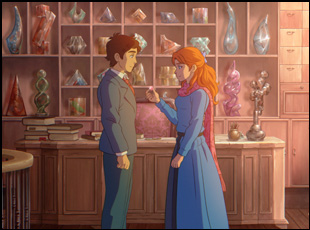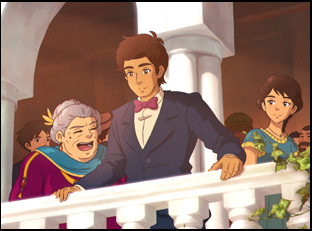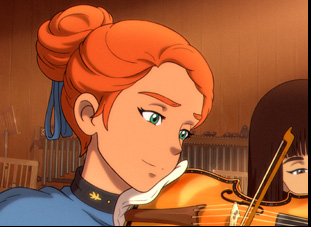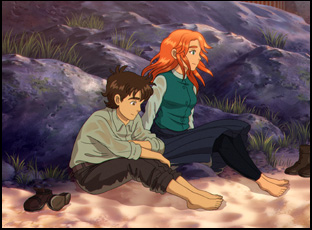Although Usman Riaz surely had an idea of what he was getting himself into with “The Glassworker,” he could only truly appreciate the plight of his main character Vincent when the film was finished and he could see the power of dreams for himself. Telling the story of someone who worked so hard to make objects of ineffable beauty, Riaz could always feel close to Vincent as he embarked on not only making a film, but setting up an entire animation studio in Pakistan when the country had no such industry to speak of in order to see his vision through, but he couldn’t have imagined the final product after first telling his wife Mariam of a single scene that came to him of a girl standing in the middle of a glass shop and having it be strong enough to devote himself so fully to it over the decade that followed.
“The Glassworker” ends up being about dreams deferred when Riaz has crafted a tale loosely tied to Pakistan’s history of being a nation at war, setting the film in a generic coastal town called Waterfront, yet the lively street market where one can procure gulab jamun fresh from a boiling kettle will remind of Karachi. Vincent is raised as a pacifist by his father Tomas, making them both a bit of pariahs in a town where to not fight is considered an act of cowardice, though there is never a compelling case made to pick up arms either. If Vincent were to become a soldier, it would only be because he tires of glass blowing, a profession that he didn’t choose for himself and his father insists he stay in to preserve their family’s legacy, but his horizons are broadened upon meeting Alliz, ironically the daughter of a colonel, who has found a passion for playing the violin and has all the leeway to become whatever she’d like due to her father’s position in society, yet the realities of being constantly at war hit her too when she’s obliged to care for the wounded. Although neither are directly involved in combat, the effects of the war touch them both and complicate what otherwise would be a beautiful relationship.
There’s more than a little Hayao Miyazaki in “The Glassworker” when a Djinn roams around the shoreline to offer helpful advice to Vincent in a world where spirits can be kinder at times than humans can, but perhaps the legendary Japanese animator’s greatest influence can be seen in how Riaz embraces a personal approach to make something truly unique. Riaz’s full investment is felt but not necessarily seen when the director realized the story he saw at a scale befitting it as the first feature from the now-ongoing animation studio Mano, but it all began with thousands of storyboards that the director himself drew by hand accompanied by voice recordings made by himself and his wife to create the momentum to get the project going, a process that he documented from start to finish with the hope of inspiring others. Truly a source of national pride now when Pakistan selected the film to be its official entry to this year’s Academy Awards for best foreign film, “The Glassworker” is touching down in the U.S. for the first time this weekend at the animators’ conference Lightbox Expo in Los Angeles and before making the trip to the States, Riaz generously took a moment to talk about how he was able to return to his first love of animation after becoming an accomplished musician, starting an animation studio from scratch and creating something bigger than himself with what ultimately became a global effort.

It’s been the journey of a lifetime, and going into it, I didn’t think it would take 10 years. I thought it would take five to six, but I am an artist and an animator and the naïveté of the thought process was, “Oh, I know how to do it, how hard can it to start a studio?” It took almost two years to set up the studio and we trained every single person in Pakistan how to do this style [of animation], and because we weren’t getting any funding, we had to do Kickstarter, [which] allowed us to make a pilot in 2016. In 2018, we finished a pilot animation which was around six minutes in length and just showcased to everybody what we could achieve in Pakistan. That allowed us to raise more financing and actually embark on making the entire feature film in 2019.
But I’ve been at this since 2014. I grew up drawing, and there was just something so magical about the world of hand-drawn animation. I grew up watching the Studio Ghibli films before I even knew who Hayao Miyazaki or Isao Takahata were, but I put it in the back of my mind because Pakistan doesn’t have any hand-drawn animation industry, so I thought, “Okay, if someone starts a hand-drawn animation studio in Pakistan, I will join and assist them, but I’ll pursue music for now.” And music started taking off. I was selected for the TED Senior Fellowship when I was 21, and they pick 12 people who they think are doing innovative and interesting work from all over the world to come and be a part of TED for a year, speak on the stage, and it was actually the TED environment, as I kept attending the conferences and watching all of these remarkable people, people like Elon Musk and Steven Spielberg [that made me think] “Okay, if they can do these huge things, I can do hand-drawn animation in Pakistan.” That was where everything started, and I wanted to do it the way I was familiar with all of my heroes, like how Miyazaki and Mamoru Hosoda draw their the storyboards, so I drew the entire film out and I kept pushing for this to be made. And somehow we’re here 10 years later with the finished film.
Part of what makes it special is how specific to Pakistan it is, but at the same time, you brought in a number of international collaborators from Moya O’Shea, your co-writer, and Geoffrey Wexler from Studio Ponoc, and “Buñuel in the Labyrinth of the Turtles” producer Manuel Cristobal. What was it like to build those relationships?
Initially, there were two drafts of this story — one which was the ambitious story I wanted to tell and then one more realistic, “Okay, this is what we can do in Pakistan with a very small team” version. And when Moya and Geoff came on, they saw the first draft of the story and said, “Why aren’t we doing this one?” And I thought, “How on earth are we going to make this with our tiny team in Pakistan?” But I’m glad they pushed me. Moya said, “No, incorporate all your other ideas into it and we’ll help.” So all of the airships and the war scenes, I [thought] the war [would be happening] on the outskirts, but then it starts affecting the lives of the people in the town, but they really encouraged me to incorporate everything into it and it became the more ambitious version of the story.
At the end of the day, we had to figure everything out ourselves, which was an amazing and tremendous learning experience, but as the project started being noticed in the animation industry, other people started coming on board. It was a huge honor when Manuel Cristobal came aboard because he was the producer behind a film called “Wrinkles,” [which was] distributed by Studio Ghibli in Japan. So I knew about him and to have him come on board, it was like, “Wow, this is amazing. He believes in the project” and it gave us the wind in our sails to keep pushing. Every few years, some amazing milestone would happen that would give us the motivation to keep going because it was so difficult to make this film. Every single frame and background was drawn and painted by hand. I got to work with a remarkable team in Pakistan and then later a remarkable team internationally who believed in this vision and wanted to see it through.

I didn’t want to shove any messaging down anyone’s throat in terms of this is what life was like in Pakistan, but I wanted to evoke that feeling of what it felt like growing up Pakistan versus just showing reality for what it was. People can start putting themselves in the characters’ shoes when it’s a little bit more fantastical and what I wanted to do was not base the film in Pakistan, but take hints of the culture and put it into this fantastical setting, which I called Waterfront Town. I think that was the right decision, because if I had based it in Pakistan and talked about all these wars, it would have become more of a political statement because that dilutes the messaging as well. I want you to feel for these characters. And that line that Alliz says at the end of the film, “Without art and music, what do we have in this world full of conflict and war?” I wanted that to resonate, because that is what kept me going in those times in Pakistan.
Now, obviously I didn’t see any of the warfare happening, but it was happening around me and in all of the neighboring areas and there was always this underlying tension as you were growing up. You ignore it when you’re a child, but as you get older, you start acknowledging that no, it was there, there was tension and this constant sense of anxiety. What effect does that have on a child or somebody growing up during that time? Those were all the things I wanted to try and capture in what happens to the characters.
The father-child dynamics are really fascinating when you show how the colonel is very encouraging of his daughter Alliz and whatever artistic pursuits she has, but the opposite is true for Tomás, who works in this very noble and artistic profession, but discourages his son from pursuing anything else. How did that idea come about?
This is something that I’ve seen very much in Pakistan and most of South Asia, where people admire the arts, but they go into more conventional fields of work according to what society dictates, but that longing and appreciation for the arts is still there. I grew up around so many talented people in school who were brilliant artists and musicians, who, if they had just kept at it, I would’ve loved to see what they could have done with these amazing gifts that they had. But because they were growing up in Pakistan, they had to go into more conventional fields, becoming a doctor or an engineer. And I have nothing against those fields, but I always wondered if they had kept going, where would they have ended up?
So the story that I envisioned for the Colonel’s character is he could have been a brilliant musician, but because he was forced into the military by his demanding father, who [can be seen] in the portrait on the mantelpiece, he’s not letting his daughter go through those same things and I wanted to show that trauma that he went through that affected him and allowed him to let Elise pursue the crafts and then the relationships that they have with each other. I pick up from things around me, so they’re inspired by a lot of people who I’ve seen that I found interesting.

With both Elise and Vincent, I viewed them as two separate sides of the things that I do. I’m an artist and an animator and a filmmaker, so that craftsmanship side is there and I can really relate to the things Vincent is doing in terms of working with his hands and trying to create something and then the more cerebral and performance side of music in Alliz. I grew up playing classical music and I have nothing against classical music — it’s one of the most incredible fields that we have — but it’s very repertoire heavy. You have to learn a lot of the great composers’ works, and then it’s your rendition of those works that makes you unique and when I was growing up, I wanted to write my own music. That’s when I started truly feeling free, when I broke out of the conventions of what the field has, and started writing my own compositions. So that dialogue that Vincent and Elise have is a very personal one and something that I struggled with as a kid — that I’m not making anything original. It’s just my original interpretation of these other compositions — and with both characters, I could really relate to what they both did. I’m hoping that because I could relate to it, that other people who follow similar things do similar things would be able to see themselves in the characters.
On both a practical and figurative level, was it interesting from somebody that played in the orchestra to conducting the whole thing as far as this big operation is concerned?
Of course, I had a lot of help with the score. I wrote out the compositions and my friend, Carmine DeFlorio, a brilliant composer, wrote a few of his and we would sit together and piece together the music and he worked on scoring to picture. He did a wonderful job. And I worked with a remarkable team, both in Pakistan and internationally, that really helped bring this project to life because there’s no way anybody can do something like this on their own, so I’m very, very grateful that everybody who was a part of the project believed in it. Having said that, it was very, very difficult, just maintaining everybody’s passion and keeping that camaraderie with the team moving forward.
That’s why I’m very grateful that Khizer [Riaz], my cousin, was the producer on the film and Mariam [Riaz Paracha], my wife, was the art director and assistant director on the film, so they were two people who I knew I could trust very, very much and and coming out of it now, I acknowledge how difficult it was, but also I’m beginning to miss it. I would love to go back to that and just start making something again. The process of creation is just so fascinating when you’re sitting there and other people’s ideas come in and you make the the product even better than how you imagined it.

The most amazing feeling was sitting in Annecy for the first time [where the film made its world premiere] and sharing it with an audience that knows a lot about animation. And I think George Lucas said in one of his interviews, “Nobody’s going to care how hard it was for you to make the film that you’re making. It has to work and you have to make a film within the circumstances that you have.” That [screening] was very, very special because all of the struggles just vanished and they were just watching the movie for what it is. And I wanted everybody to understand that yes, it was difficult for us, but it should not matter when you watch the movie. I want the movie to speak for itself. And I’m very, very grateful that it does.
If anybody’s interested in understanding what the journey was like, that’s why I made that [feature-length] documentary because I grew up watching all of these behind the scenes featurettes and they inspired me so much. I wanted to make one so that other people could find inspiration and it doesn’t have to be in filmmaking. It can be in anything they want to pursue and they just see the struggles and are motivated to move forward. That was very important to me. These last few months have been an eye-opening experience because I spent essentially 10 years in a cave making this thing and now I’m showcasing it and there’s a lot of joy in that process because ultimately, that’s what movies are. It’s the kingdom of dreams and madness. It’s wonderful and intimidating as well because I would like to keep pushing and moving forward. Now we were selected for Pakistan’s submission to the Academy Awards and that’s another very difficult journey up ahead, so I’ll see how far I can take it. But at the end of the day, I just love this craft more than anything in the world and I’m willing to go to the ends of the earth for it.
“The Glass Worker” will make its U.S. premiere at Lightbox Expo in Los Angeles on October 25th at 10 pm at the Pasadena Convention Center.




